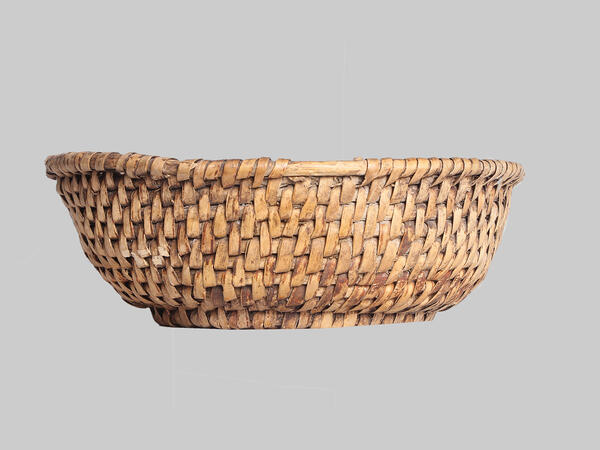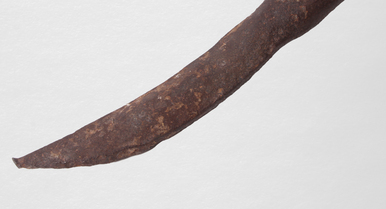Siberia territory settlement began more than five centuries ago. The history of Mariinsk is closely connected with the development of Siberian land. The museum houses a whole collection of personal belongings and household items of the settlers. One of these exhibits is a bast bowl made in the beginning of the 19th century. It was used to store and carry food.
Bast bowls were inexpensive, light and relatively firm. This material was extracted from deciduous trees, most often linden, and in order not to damage the bast, craftsmen had to know the structure of the trunk pretty well.
The tree trunk is formed by wood that grows annual rings, i.e. growth rings. The middle of the trunk is sturdier than the rest of it. It is called the heartwood, or duramen. Closer to the edge there is a sapwood, the living, softer wood. The outside of the trunk is protected by the bark. Between the bark and the sapwood there is a thin layer producing cells: during the warm season, they create layers of wood inside the trunk and bark cells outside. This most important layer of cells for the tree and its surroundings is called the bast.
The linden bark can be easily stripped from the tree starting from spring up to the end of July, when the sap ascent stops. However, it was not common to do it in spring: makers waited for a thicker layer by midsummer. If women started to gather bast, the linden trees were not felled. The bast was picked from a standing tree by making notches near the root and above the head as far as the hands could reach. The cut bark was rolled into skeins: the bands were twisted with the bast side out and the bark inside. The skeins were tied with thin strips of the same bast and put together with the linden blanks into the boat.
After arriving home, the makers soaked these skeins in water near the shore. To keep them from floating away, they were pressed with rocks. The place for soaking was shallow and quiet. Later, the skeins were dragged on the shore and unraveled. The resulting ribbons of bark were hung along wooden walkways on special poles for drying and mending nets, i.e. field stands.
Well-soaked bast could be easily separated from the bark. It was usually done with bare hands without any tools, and a knife was used to remove the coarse fibers. Thick and wide multi-layered bast ribbons were divided into equal strips and arranged in different bundles depending on the quality and length of the fibers. The finished ribbons were used to create dishes, bast shoes and other household items.
Bast bowls were inexpensive, light and relatively firm. This material was extracted from deciduous trees, most often linden, and in order not to damage the bast, craftsmen had to know the structure of the trunk pretty well.
The tree trunk is formed by wood that grows annual rings, i.e. growth rings. The middle of the trunk is sturdier than the rest of it. It is called the heartwood, or duramen. Closer to the edge there is a sapwood, the living, softer wood. The outside of the trunk is protected by the bark. Between the bark and the sapwood there is a thin layer producing cells: during the warm season, they create layers of wood inside the trunk and bark cells outside. This most important layer of cells for the tree and its surroundings is called the bast.
The linden bark can be easily stripped from the tree starting from spring up to the end of July, when the sap ascent stops. However, it was not common to do it in spring: makers waited for a thicker layer by midsummer. If women started to gather bast, the linden trees were not felled. The bast was picked from a standing tree by making notches near the root and above the head as far as the hands could reach. The cut bark was rolled into skeins: the bands were twisted with the bast side out and the bark inside. The skeins were tied with thin strips of the same bast and put together with the linden blanks into the boat.
After arriving home, the makers soaked these skeins in water near the shore. To keep them from floating away, they were pressed with rocks. The place for soaking was shallow and quiet. Later, the skeins were dragged on the shore and unraveled. The resulting ribbons of bark were hung along wooden walkways on special poles for drying and mending nets, i.e. field stands.
Well-soaked bast could be easily separated from the bark. It was usually done with bare hands without any tools, and a knife was used to remove the coarse fibers. Thick and wide multi-layered bast ribbons were divided into equal strips and arranged in different bundles depending on the quality and length of the fibers. The finished ribbons were used to create dishes, bast shoes and other household items.



